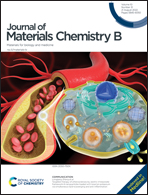A starch-regulated adhesive hydrogel dressing with controllable separation properties for painless dressing change†
Abstract
The development of hydrogel dressings provides unprecedented opportunities for clinical medicine. However, the traditional hydrogel dressings cannot achieve controllable adhesion and separation, which often brings unbearable pain and secondary damage to patients during removal. In this work, a starch-regulated adhesive hydrogel dressing with controllable separation properties is reported. This hydrogel dressing can achieve rapid separation through the dissociation competition mechanism of polar small molecules, which will not cause any damage or discomfort to the skin or tissues, and greatly facilitate dressing replacement. The adhesive strength of the hydrogel reaches 0.06 MPa, and remains relatively stable after repeated utilization. Meanwhile, the inhibition rate of the hydrogel for E. coli, S. aureus and C. albicans is more than 99.9%. At the same time, the hydrogel also has good swelling properties, mechanical properties and biocompatibility, and exhibits a high healing efficiency (95.01 ± 3.76%) in a rat full-thickness skin defect model. This novel hydrogel dressing with controllable separation properties provides a facile and effective method for wound management and treatment, and has great promise for long-term application of wound dressings.



 Please wait while we load your content...
Please wait while we load your content...